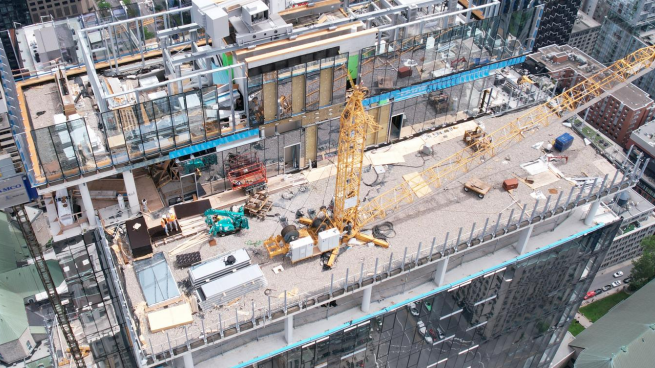Crane struck two steel posts causing them to fall from Montreal's tallest residential tower

A fatal accident at Montreal’s tallest residential tower, 1 Square Phillips, prompted a sweeping investigation and calls for industry-wide reform. On June 19, 2024, a derrick crane dismantling operation on the 61st floor went catastrophically wrong. As workers from Les Constructions L.J.P. inc. rotated the crane’s boom, it struck two steel posts—each weighing about 109 kilograms—anchored to the rooftop’s permanent guardrail. Both posts broke free and fell to the ground. One fatally struck Vito Fundaro, a 26-year-old supervisor for Les Entreprises Fundaro inc., who was working at ground level. The other damaged a nearby service vehicle.
The Quebec workplace safety board, CNESST, released its investigation report, laying blame on a series of preventable errors. Investigators found that “a supervisor at the base of the building [was] fatally struck by a steel post that detached from its base on the 61st floor, after being hit by the derrick boom.” The report further stated, “The evaluation of the space required for the rotation of the derrick boom [was] incorrect. The management of the derrick dismantling work [was] deficient in terms of planning and supervision.”
Technical analysis revealed that the force of the crane’s boom exceeded the strength of the welds anchoring the posts. “The force applied by the boom [was] sufficient to cause the welds to fail,” the report noted. A separate technical review by safety firm Technorm found “important defects” in the welds, explaining that “almost the entire weld bead remained on the bases when the posts detached. This type of defect, called lack of fusion, weakened the assembly and reduced its load-bearing capacity.”
The investigation also uncovered lapses in site safety and supervision. The worksite lacked proper safety perimeters, and the planning process failed to account for the presence of the guardrail posts. The operator in charge of dismantling the derrick was inexperienced and left unsupervised. “The employer did not ensure that the worker had the training, skill, and experience required to safely carry out the work,” the report said. “For the first time, he had to coordinate the dismantling of the derrick, the operations, and the work of his colleagues, without support or supervision from his employer.”
In the wake of the accident, CNESST halted all work on the 61st floor and required engineering certifications for the guardrails before operations resumed. The board stressed that such tragedies are avoidable. “Accidents like this can be prevented by following manufacturers’ instructions, securing work areas, and ensuring proper training and supervision,” the report concluded.
Labour Minister Jean Boulet offered condolences to Fundaro’s family, while Magil Construction, the site’s manager, evacuated the site and provided psychological support to workers. Unions called for a coroner’s inquest, highlighting the persistent dangers facing Quebec’s construction workers.
As Montreal’s skyline continued to rise, the CNESST’s findings stood as a stark reminder: rigorous planning, strict supervision, and unwavering adherence to safety protocols remained essential to prevent such devastating loss.




